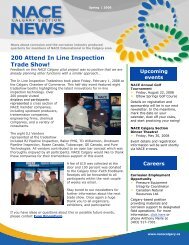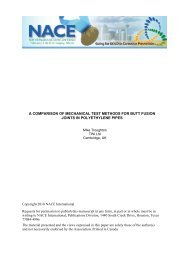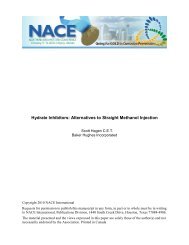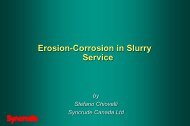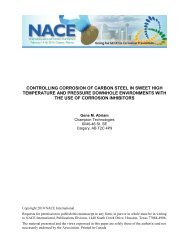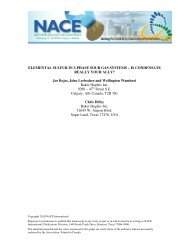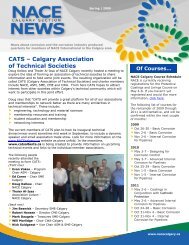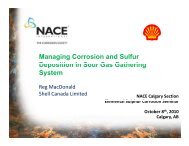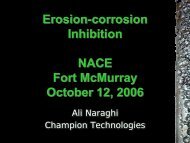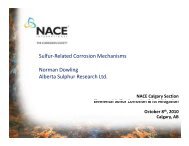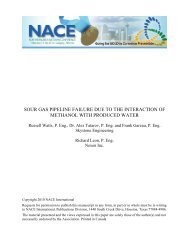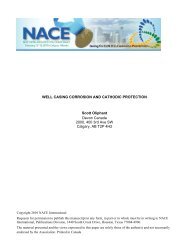Nace Calgary Section News Spring 2012
Nace Calgary Section News Spring 2012
Nace Calgary Section News Spring 2012
Create successful ePaper yourself
Turn your PDF publications into a flip-book with our unique Google optimized e-Paper software.
SPRING | <strong>2012</strong><br />
Fall 2011 page 1<br />
<strong>News</strong> about corrosion and the corrosion industry produced<br />
quarterly for members of NACE International in the <strong>Calgary</strong> area<br />
Register now for annual dinner!!!<br />
This year’s dinner features wellknown<br />
Canadian stand up comic<br />
- Marcus C. Beaubier. Marcus<br />
hails originally from Newfoundland,<br />
and has been trying to escape the<br />
stereotype ever since. The fact that<br />
he lives in Alberta now, really<br />
doesn’t help his cause. This irony is<br />
not lost on him. It has tempered his<br />
sense of humour, making him<br />
wickedly funny.<br />
Whether he’s raging on about pop<br />
culture, personal relationships, or<br />
politics, his fiery wit focuses in on the subject like a laser beam.<br />
He was one of the founding members of “The Audiotoon<br />
Theatre”, a sketch comedy troupe based out of St. John’s. He’s<br />
appeared on CBC’s “Madly Off in All Directions”, and in the past<br />
has contributed regularly to “Definitely Not The Opera.” He<br />
performs often at Yuk Yuks in <strong>Calgary</strong>.<br />
Eight NACE Members<br />
to Receive Recognition<br />
at Annual Dinner<br />
These NACE <strong>Calgary</strong><br />
members will be recognized<br />
for their many years of<br />
participation in NACE, the<br />
Corrosion Society, at the<br />
June 1 NACE <strong>Calgary</strong> dinner:<br />
25 Years...<br />
Carl Lechman<br />
Christopher Palmer<br />
Brian Stefan<br />
Brian Tkachyk<br />
35 Years...<br />
His material has been featured on XM Radio’s Laugh Attack, and<br />
has also appeared in several feature films.<br />
This year’s dinner takes place Friday, June 1, at the<br />
<strong>Calgary</strong> Chamber of Commerce Club, starting at 5:30 p.m. In<br />
addition to entertainment, the price of $60/person for the<br />
evening includes:<br />
Open bar (pending sponsorship)<br />
Four course meal at tables of 8<br />
Table wine<br />
NACE 25 and 35 year member recognition<br />
Taxi chits<br />
<br />
<br />
<br />
<br />
Roger Ingeveld<br />
Arthur Kowalchuk<br />
Reg MacDonald<br />
E. Wayne Sudds<br />
Click here to get more information, to sponsor and/or to<br />
attend.<br />
These members were honored last year.<br />
www.nacecalgary.ca
<strong>Spring</strong> <strong>2012</strong> page 2<br />
Message from the Chair - Thane Schaffer<br />
We want your ideas!!<br />
<br />
<br />
<br />
<br />
<br />
<br />
<br />
It’s been a busy three months since our last<br />
newsletter. In that time, we have sponsored a<br />
number of events and courses, made presentations<br />
to students in the new Corrosion Engineering<br />
course at the University of <strong>Calgary</strong>, and planned<br />
several networking and learning opportunities for<br />
the rest of the year. Here are a few notes on the<br />
past few months...<br />
130 people attended the Managing Corrosion in SAGD<br />
Operations Technical luncheon in March which was very well<br />
received by members.<br />
More than 100 people attended the Protective coatings<br />
tradeshow and feedback we have received is very positive, as it<br />
is for all the tradeshows we have done. If you didn’t make it<br />
this time, try to attend a future one.<br />
We are hard at work developing a ‘cloud’ archive where we can<br />
archive important executive documents, photos, technical<br />
papers and more. Members will have direct access to the<br />
technical papers archive. Dave Grzyb is looking after this and<br />
you’ll hear more about it in the next newsletter.<br />
We had arranged to have a Refinery Corrosion course for NACE<br />
members in Western Canada, but didn’t get sufficient numbers<br />
at this time to break even. We will be offering this course<br />
again in the fall. Take a look at it when we start advertising to<br />
see if it is something that would be of benefit to you.<br />
Program Chair, Matt Stroh, has taken a position with Canadian<br />
Fertilizers in Medicine Hat. Matt did a lot in recent years to<br />
develop a rich and well-rounded program for NACE <strong>Calgary</strong><br />
members, and we wish him all the best in his new role. Cat<br />
Taylor will be replacing Matt as Program Chair in June.<br />
We will be doing our biennial member survey in the next<br />
month – please take a few minutes to respond to it as the<br />
results will help us to serve you better.<br />
Click here to email me if you would like to help out with a<br />
satellite seminar we are planning in Medicine Hat next fall,<br />
or if there is a course or event you would like us to consider in<br />
the next year.<br />
Of Courses...<br />
• June <strong>2012</strong> - Edmonton:<br />
PCS 1 - June 3-5<br />
PCS 2 - June 6-8<br />
Click here for more<br />
information and to register.<br />
• June 10-16, <strong>2012</strong><br />
Cathodic Protection<br />
Technologist (CP3) – <strong>Calgary</strong><br />
Click here for more<br />
information and to register.<br />
• June 25-29, <strong>2012</strong><br />
Internal Corrosion –<br />
Advanced - <strong>Calgary</strong><br />
Click here for more<br />
information from NACE<br />
International.<br />
• Oct. 21-26<br />
Internal Corrosion Basic –<br />
<strong>Calgary</strong>. Registration<br />
available in July <strong>2012</strong>.<br />
• Oct. 22- 26<br />
Basic Corrosion – <strong>Calgary</strong>.<br />
Registration available in July<br />
<strong>2012</strong>.<br />
• Oct. 29 - Nov 4<br />
Basic Corrosion –<br />
<strong>Calgary</strong>. Registration<br />
available in July <strong>2012</strong>.<br />
www.nacecalgary.ca
<strong>Spring</strong> <strong>2012</strong> page 3<br />
NACE Members<br />
Like Tradeshows!<br />
More than 100 people attended the Protective Coatings Tradeshow on April 27. NACE received excellent<br />
feedback from both attendees and sponsors. The event included eight vendors, lunch, coffee and drinks, two<br />
presentations, and the opportunity to network with colleagues and suppliers. Thanks to a number of great<br />
vendors and sponsors, it was possible to deliver this amazing learning value for only $20/person.<br />
VENDORS:<br />
International Paints<br />
BAR SPONSORS:<br />
Special thanks to our two guest speakers!...<br />
<br />
<br />
Amal Al-Borno (above), from Charter Coating<br />
Service (2000) Ltd. – Selecting Epoxy Coatings –<br />
Common Mistakes and Best Practices<br />
Dave Walker , ShawCor CSI Services – Internal<br />
Pipe Spool Coating Best Practices<br />
Enerclear Services Inc.<br />
COFFEE AND DRINKS:<br />
LANYARDS:<br />
VISCOTAQ<br />
Polyguard RD6 Geotextile Backed Tape<br />
(In-Line Pigging Systems)<br />
www.nacecalgary.ca
Winter <strong>2012</strong> page 4<br />
New Corrosion Course at U of C<br />
Executive members Thaier Al Issa and Jana<br />
Johnson recently gave presentations to students in<br />
the new Corrosion course sponsored by NACE at<br />
the U of C. Twenty students are participating at<br />
this time and the course has been a great success.<br />
Jana’s presentation focussed on corrosion<br />
monitoring, and Thaier’s presentation was a case<br />
study on ‘Corrosion and Stress Corrosion Cracking<br />
of Steel Pipeline under Disbonded Coating’.<br />
Annual SAIT Bursaries<br />
Making a difference -<br />
one student - and one<br />
teacher - at a time!<br />
“Students who understand<br />
and are excited about the<br />
sciences often become the<br />
world's most successful<br />
innovators.”<br />
This year’s ASM/NACE<br />
<strong>Calgary</strong> Materials Camp for<br />
Teachers takes place June<br />
18-22, <strong>2012</strong> at the SAIT<br />
Campus. This is one of many<br />
such camps that will take<br />
place throughout Canada and<br />
the US. To date 21 teachers<br />
out of a potential of 25 have<br />
already registered.<br />
These camps have a<br />
measurable impact as they<br />
inspire teachers to inspire high school students to<br />
continue on the path toward fulfilling science and<br />
engineering careers.<br />
Benefits to teachers who participate include:<br />
No Program Fees<br />
Free housing at residential camps<br />
The opportunity to learn hands-on from<br />
"Master Teachers"<br />
They leave with complete lesson plans and<br />
budget-oriented projects<br />
Doug Kellow presents NACE <strong>Calgary</strong> bursary to SAIT<br />
student Chun Wu Zeng at a recent SAIT awards event.<br />
NACE <strong>Calgary</strong> is proud to provide six $1,000<br />
bursaries annually to SAIT technology students in<br />
the McPhail School of Energy who have a career<br />
interest in corrosion related sciences. This year’s<br />
recipients are:<br />
Taimoor Tahir, Chemical Engineering<br />
Zhi Fang, Chemical Laboratory<br />
Darren Gross, Mechanical Engineering<br />
Chung Wu Zeng, Petroleum Engineering<br />
Logan Daines, Power Engineering<br />
Darren McLean, Welding Engineering<br />
We couldn’t do it without sponsors<br />
Thanks to all of our generous sponsors to date:<br />
SAIT – for the classroom, labs and lab tours<br />
ASM Materials Education Foundation<br />
ASM <strong>Calgary</strong> <strong>Section</strong><br />
ASME<br />
AUTO21 Network of Centres of Excellence<br />
Cement Association of Canada<br />
Enbridge<br />
NACE <strong>Calgary</strong> <strong>Section</strong><br />
Talisman Energy<br />
ERCB.<br />
But we need a few more...<br />
...to provide housing for teachers attending from<br />
outside of <strong>Calgary</strong>. Please contact Jana Johnson for<br />
more information at membership@nacecalgary.ca<br />
www.nacecalgary.ca
<strong>Spring</strong> <strong>2012</strong> page 5<br />
SAGD Luncheon a Big Success<br />
Cat Taylor, NACE <strong>Calgary</strong> Program Committee<br />
The March, NACE <strong>Calgary</strong> technical luncheon on Managing Corrosion in SAGD<br />
Operations was very well received, with 130 in attendance!<br />
The presentations were informative, innovative and entertaining. Joe Bojes<br />
(Baker Hughes) talked about “Key Learnings in the Evaluation of Corrosion and<br />
the Development of a Corrosion Inhibitor for Ultra-High Temperature, High CO2,<br />
SAGD Well Applications”. And the presentation by Laila Abu-Abed (Cenovus)<br />
focused on “Corrosion Monitoring Maps”.<br />
NACE <strong>Calgary</strong> co-sponsored eight University of <strong>Calgary</strong> Corrosion Course students<br />
at the event, along with their professor. Thanks to Weatherford for their<br />
contribution towards making this possible.<br />
The students later expressed their thanks, saying they appreciated the<br />
opportunity “to learn and to network with subject matter experts from industry<br />
sectors all around Alberta…”, and to “discuss future career opportunities<br />
and challenges in Alberta Oil and Gas markets.”<br />
The success of our events is directly related to corporate sponsorships,<br />
and we are very grateful to Baker Hughes and RAE Engineering for making<br />
this event possible.<br />
Executive Pipeline to the Membership...<br />
NACE Biennial Survey<br />
Every two years, since 2006, NACE <strong>Calgary</strong> has been surveying members in order to:<br />
Gather your perceptions about membership in NACE International and<br />
about membership in the NACE <strong>Calgary</strong> <strong>Section</strong><br />
Find out what kinds of programs and services you would value as a<br />
member<br />
Get your views on where we need to do things differently or better<br />
See changes in needs and wants of members over time.<br />
The Calagary Executive uses the information from the survey to better<br />
understand the demographics of the NACE <strong>Calgary</strong> membership and to utilize<br />
member input as they plan for courses, events, industry promotions and other activities for or on behalf of<br />
members.<br />
This year, the online survey will be distributed in May, with the hopes that<br />
the NACE <strong>Calgary</strong> Executive will have a good response prior to a planning<br />
meeting scheduled for mid June.<br />
When you receive an e-notice for the survey, please take a few minutes<br />
to provide your thoughts and ideas.<br />
www.nacecalgary.ca
Winter <strong>2012</strong> page 6<br />
For your information...<br />
Assembled by Thaier Al-Issa, M.Eng. P.Eng.<br />
…Presenting some of the worst corrosion related failures recorded in Canada & around the world.<br />
This column features a Canadian case of Refined Product Pipeline Rupture – OPERATOR: Trans-<br />
Northern Pipelines Inc., Near Saint-Clet, Quebec - 07 December 2002.<br />
“On 07 December 2002, Trans-Northern Pipelines Inc. (TNPI) was delivering refined petroleum products from<br />
the Montréal, Quebec, refining basin into the Ottawa, Ontario, terminal storage facilities.<br />
At 10:43 EST, the pipeline Control Centre Operator (CCO), located at the company's Mainline Control Centre<br />
(MCC) in Richmond Hill, Ontario, initiated a series of operations to start a scheduled full stream delivery of<br />
products into Cornwall, at Kilometre Post (KP) 119.09 (Mile Post [MP] 74.5). The CCO began by setting the<br />
Cornwall Inlet Control Valve (ICV) to 3585 kilopascals (kPa) (520 psig) to maintain mainline pipeline pressure<br />
and avoid an overpressure (OP) situation. At 10:52 EST, the CCO commanded the Cornwall Mainline Block<br />
Valve (MLV), located downstream Cornwall delivery point, to move to the fully closed position, resulting in the<br />
start of the full stream delivery of refined products into Cornwall. At that moment, Cornwall TOV moved to<br />
the fully closed position. The Cornwall meter manifold had just experienced a high-pressure condition, which<br />
prompted an alarm signal. The mainline pressure at Cornwall rose to 7019 kPa (1018 psig) and the Lancaster<br />
pump station then automatically shut down on a high pipeline pressure condition. The Supervisory Control<br />
and Data Acquisition (SCADA) system showed operational upset had occurred. In addition, the CCO observed<br />
that the pressure in the mainline pipeline suddenly dropped while the inlet pressure at Lancaster surged from<br />
875 kPa (127 psig) to 7460 kPa (1082 psig) and then receded to 193 kPa (28 psig).<br />
At 10:54 EST, the mainline pressure at Cornwall had reached 6047 kPa (877 psig). The Cornwall ICV was<br />
reset by the CCO to a mainline pressure of 8964 kPa (1300 psig) and the flow of product out of Montréal was<br />
commanded to shut down. At this point, the CCO suspected that a line rupture had occurred and initiated the<br />
isolation of the pipeline system by taking the Como pumping unit off line, at KP 51.17 (MP 32).<br />
At 10:56 EST, a line balance alarm was issued to the CCO indicating a loss of product from the pipeline, which<br />
was later determined to be approximately 32 cubic metres of low sulphur diesel released from the pipeline.<br />
At 12:55 EST, TNPI's aerial patrol identified a product stain on TNPI's right-of-way, in a field east of the<br />
Saint-Emmanuel drainage system, just east of Saint-Clet, at KP 63.57 (MP 39.5). There was a hole in the soil<br />
over the pipeline at the point of rupture, measuring 91 cm in diameter. Approximately 180 m (588 feet) east<br />
of the Saint-Emmanuel drainage ditch, which was partially covered by snow, an area 18 m by 12 m had been<br />
covered with fuel. The rupture occurred in the middle of a farmer's field with access available through a<br />
bridge that crosses the Saint-Emmanuel drainage ditch.There were no injuries.”<br />
(http://www.tsb.gc.ca/eng/rapports-reports/pipeline/2002/p02h0052/p02h0052.asp)<br />
Schematic of the Trans-Northern Pipelines Inc.<br />
Pipeline System from the Montréal Pump<br />
Station to the Ottawa Terminal<br />
http://www.tsb.gc.ca/eng/rapportsreports/pipeline/2002/p02h0052/p02h0052.asp<br />
www.nacecalgary.ca
Winter <strong>2012</strong> page 7<br />
History of the Pipeline:<br />
“The section of pipeline that ruptured was manufactured in 1952 by Stelco, using the Electric Resistance<br />
Welding process and a pipe grade of steel of 317 MPa (API 5LX, X-46).The pipe section had an outside<br />
diameter of 273.1 mm (10 inches) and a wall thickness of 7.8 mm (0.307 inch).<br />
The pipeline was installed with 0.60 m (2 feet) of minimum cover. At the occurrence site, the pipe depth of<br />
cover was 0.61 m. In 1987, TNPI lowered the pipeline across the drainage ditches located at either end of the<br />
field in which the occurrence took place. The nearest field bends (sags and over-bends) were located on<br />
either side of the property at the ditch crossings.<br />
The pipe was externally coated with a Coal Tar Enamel coating and was protected against corrosion with a<br />
Cathodic Protection system. The pipeline was hydrostatically tested for 24 hours to a minimum pressure of 10<br />
342 kPa (1500 psi). In 1952, the Board of Transport Commissioners granted TNPI leave to operate with an<br />
MOP of 8274 kPa (1200 psig). The elevation difference between the rupture site in Lot 11, which is estimated<br />
at 53.3 m above sea level (asl) and the Saint-Polycarpe block valve, which is estimated at 52.5 m asl, is<br />
nominal. Lancaster pump station to the west is estimated at 53 m asl.”<br />
(http://www.tsb.gc.ca/eng/rapports-reports/pipeline/2002/p02h0052/p02h0052.asp)<br />
Analysis:<br />
“The Cornwall TOV moved suddenly, without any instruction from the CCO, from the fully opened position to<br />
the fully closed position, as a result of a high manifold pressure condition that prompted the alarm signal to<br />
the CCO and a shutdown of the system. A pressure surge was generated in the mainline, travelled up<br />
the pipeline toward Montréal and ruptured the pipe at a zone of third-party damage.<br />
A section of the ruptured pipe, approximately 8 m (26 feet) long, was shipped to the TSB Engineering<br />
Laboratory. The analysis (report LP 113/02) revealed that the rupture occurred at the three o'clock position<br />
with a rectangular "fish mouth" opening tear measuring approximately 1 m (40 inches) long. The fracture ran<br />
parallel to the pipe's longitudinal seam, and was located 9 to 10 cm (3.5 to 4 inches) away. The fracture<br />
occurred within a deformed and mechanically scored area. The pipe was deformed approximately 10 mm<br />
inward, which represents 3.5 per cent of the outside diameter. On its outer surface, longitudinal dents and<br />
grooves extended 2.7 m (9 feet) beyond the fracture zone.<br />
The fracture face appeared fresh, with the exception of a series of semi-circular areas along the initiating<br />
fracture surface. Pre-existing cracks extended to a maximum depth of 40 per cent of the nominal pipe wall<br />
thickness, and initiated in the region of the noted mechanical scoring or damage on the pipe outer surface.<br />
At the 10ºC operating temperature of the pipe, Charpy impact test2results averaged 7 Joules (5 footpounds).<br />
These values are consistent with the materials used in 1952, but today's standards require a<br />
minimum of 27 Joules (19.9 foot-pounds) for a pipe with an outside diameter smaller than 457 mm (18<br />
inches). The purely theoretical analysis using generalized assumptions, conducted by the TSB Engineering<br />
Laboratory, calculated that the static pressure required to rupture the damaged pipeline would have been<br />
between 11 032 and 15 169 kPa (1600 and 2200 psig).”<br />
(http://www.tsb.gc.ca/eng/rapports-reports/pipeline/2002/p02h0052/p02h0052.asp)<br />
Findings as to Causes and Contributing Factors:<br />
The un-commanded operation of the automatic Cornwall take-off valve resulted in an unscheduled<br />
shutdown of the station at a time when the line pack was increasing from Como operations, along with<br />
a pressure surge of between 11 032 and 15 169 kPa (1600 and 2200 psig), causing the rupture of the<br />
pipe. Since there was no check valve at Lancaster, or flow control and overpressure protection on the<br />
mainline, the high-pressure surge was carried upstream past Lancaster, subjecting the mainline to<br />
high stresses that led to the failure of the pipe.<br />
The pipe failed from an instantaneous overstress extension of pre-existing cracks, which had initiated<br />
in the region of mechanical scoring and damage on the outer pipe surface and had been caused<br />
previously by unauthorized third-party construction activity. It was consistently concluded that the inline<br />
inspection (ILI) indication at the occurrence site was a field bend and did not present a threat.<br />
www.nacecalgary.ca
Winter <strong>2012</strong> page 8<br />
Even though the reliability of the ILI tool has been significantly enhanced since 1980, the lack of<br />
training on new ILI technology and the infrequent opportunities to practice methods of interpreting<br />
integrity inspection results likely influenced the ILI data analysts to conclude in 1993 and in 1998 that<br />
no threat existed at the occurrence site.<br />
Had the company performed a field excavation or reviewed route alignment drawings for the pipeline<br />
or performed a standard engineering calculation, it would likely have discovered that the feature<br />
detected by the ILI tool was not a field bend.“<br />
(http://www.tsb.gc.ca/eng/rapports-reports/pipeline/2002/p02h0052/p02h0052.asp)<br />
(For more details, please refer to TSB Pipeline Investigation Report - Report Number P02H0052)<br />
Schematic of the Cornwall Meter Station,<br />
http://www.tsb.gc.ca/eng/rapportsreports/pipeline/2002/p02h0052/p02h0052.asp<br />
Schematic of the Lancaster Pump Station<br />
http://www.tsb.gc.ca/eng/rapportsreports/pipeline/2002/p02h0052/p02h0052.asp<br />
References: http://www.tsb.gc.ca/eng/rapports-reports/pipeline/2002/p02h0052/p02h0052.asp<br />
www.nacecalgary.ca
Winter <strong>2012</strong> page 9<br />
NACE <strong>News</strong> is produced four times a year<br />
by the Executive Committee of<br />
NACE <strong>Calgary</strong> <strong>Section</strong>.<br />
To provide feedback, or to submit an article or story idea,<br />
email: nacenews@nacecalgary.ca.<br />
www.nacecalgary.ca



